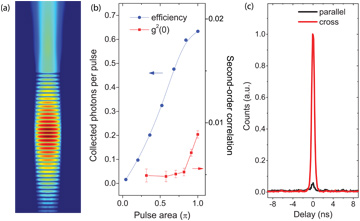 (a) Numerical simulation of photon emission from the quantum dot–micropillar. (b) The photons collected into the first lens per pulse versus single-photon purity for different pump powers. The second-order correlation, g2, gives the probability of a multiphoton event. (c) Hong–Ou–Mandel quantum interference between two single photons separated by 13 ns, with their polarization set at cross (red) and parallel (black).
(a) Numerical simulation of photon emission from the quantum dot–micropillar. (b) The photons collected into the first lens per pulse versus single-photon purity for different pump powers. The second-order correlation, g2, gives the probability of a multiphoton event. (c) Hong–Ou–Mandel quantum interference between two single photons separated by 13 ns, with their polarization set at cross (red) and parallel (black).
Single-photon sources are nonclassical devices that emit one and only one photon at a time. The idea of single photons dates to Planck and Einstein in the early 1900s. In recent decades, single-photon sources have emerged as key resources in the emerging field of quantum information, including quantum key distribution, quantum teleportation and optical quantum computing.1
To be practically useful for scalable quantum technologies, a single-photon source must simultaneously possess three qualities: high purity, photon indistinguishability and efficiency. That is, the emission must have only a vanishingly small multiphoton probability; the photons produced must be identical to one another; and they must be grouped with a high efficiency into a single spatial mode. Despite tremendous progress in demonstrations of single-photon sources, these three key prerequisites have heretofore been demonstrated only separately—a fundamental obstacle to scalable quantum photonics.
We have now developed a single-photon source that combines all three of these key features into a single device.2 Our work exploits s-shell pulsed resonant excitation of a coupled quantum dot–micropillar system to deterministically generate resonance fluorescence; the emitter is spatially coupled and spectrally resonant to the Purcell-enhanced micropillar, which acts as a microcavity.
The combination of the pulsed resonant excitation and the microcavity structure overcomes the efficiency–quality dilemma. In our experiments, the device emitted approximately 10 million single photons per second at the end of a single-mode fiber, of which a silicon detector eventually detected 3.7 million. At the saturated extraction efficiency of 66 percent, the single-photon purity remained 99.1 percent—that is, there was only 0.9 percent two-photon contribution. Hong–Ou–Mandel quantum interference, meanwhile, revealed the photons to be 0.978 indistinguishable. Overall, the results suggest a strong performance for the single-photon source in physical systems. The source is about ten times brighter than a state-of-the-art parametric down-conversion source, and requires a pump power seven orders of magnitude lower.1
Such a single-photon source should be useful in multiphoton experiments on a semiconductor chip. One important application is boson sampling—it has been estimated that, with 20 to 30 single photons, one can outperform classical computers and provide experimental evidence against the Extended Church-Turing Thesis.
Researchers
X. Ding, Y. He, Z.-C. Duan, M.-C. Chen, C.-Y. Lu (cylu@ustc.edu.cn), and J.-W. Pan (pan@ustc.edu.cn) University of Science and Technology of China, Hefei, China
S. Unsleber, S. Maier, C. Schneider, M. Kamp and S. Höfling, University of Würzburg, Germany
N. Gregersen, Technical University of Denmark, Kongens Lyngby, Denmark
References
1. J.-W. Pan et al. Rev. Mod. Phys. 84, 777 (2012).
2. X. Ding et al. Phys. Rev. Lett. 116, 020401 (2016).
